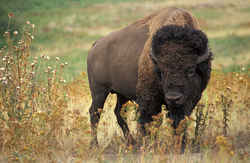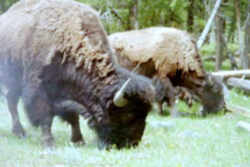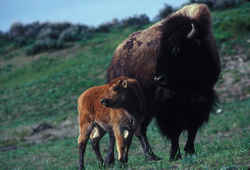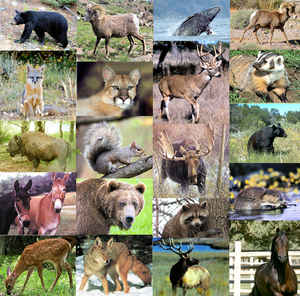Kansas State Animal
American Buffalo

(Bison bison)
Adopted on March 28, 1955.
The "American buffalo", Bison bison, was adopted as Kansas' state animal on March 28, 1955.
The American Bison is known to most Americans as simply "Buffalo". Bison differ in color, size, and shape from true buffaloes. Great herds of American Bison once roamed North America through the Appalachian Mountains and the Colorado Rockies.
The Kansas State Animal: American Buffalo

The most abundant grazing animal in North America was formerly the American Bison. One estimate of the original number of bison in North America ranged as high as 70 million animals. A single herd located southwest of what is now Dodge City, Kansas in 1871 was carefully estimated to have over 4 million members! To see anything like this today one would have to visit Africa to see the large herds of grazing animals which still remain there. Hunted for centuries, their numbers decreased and the American Bison was on the verge of extinction by 1889. Presently numbering about 5,000, they now live in herds scattered throughout the United States in preserved areas.
Near Wichita, one can see bison at Maxwell Game Refuge east of McPherson, the Konza Prairie south of Manhattan and at the Tallgrass Prairie Preserve north of Pawhuska, Oklahoma.
Did you know that: The bison has been proclaimed the official state animal or mammal in each of the following states
State Symbol: Bison
Buffalo Bison bison. The American Buffalo, or Bison, is a massive animal that weighs from 800 to 2,000 pounds and stands nearly six feet high at the shoulder. A large head, high hump on the shoulders and dark brown shaggy hair characterize the buffalo.
Bison are part of the family Bovidae, to which cattle and goats belong. They are not in the same family that Asian and African buffalo are. However, because they resembled these old world animals, the early explorers called them by that name. Although it is a misnomer, the name buffalo is still used interchangeably with bison. One of the physical differences between the old world buffalo and the American bison is the large shoulder hump of the bison. This hump, along with a broad, massive head, short, thick neck and small hindquarters give the animal its rugged appearance.
Physical Characteristics

The body of the bison is huge, ranging in length from 3.6 m to 3.8 m in males to 2.13 m to 3.18 m in females. They are also tall animals, with the height at the shoulder ranging from 1.67 m to 1.86 m for males and 1.52 m to 1.57 m in females. Two distinctive features of the bisons are the shoulder hump and their huge head. The color of the bison is brown, varying slightly from the front and back of the animal. The hair is longer in the front than in the rear of the bison. The distinction between hair length is more noticeable in males than females. The horns of the bison are black, and they curve upward and inward, ending in a sharp tip. The legs of the bison are short but firm. The hooves are black and are circular in shape (Meagher, 1986).
Food Habits
Bison are year round grazers. They feed primarly on grasses, but when food is scarce, they will eat vegetation such as sagebrush. On the average, bison ingest 1.6% of their body mass per day of dry vegetation. Bison require water every day as well (Meagher, 1986).
Reproduction
Females are sexually mature in two to three years and males reach maturity around age three. Bulls, however, do not breed until six years of age. The breeding season begins in late June and lasts through September. Gestation is around 285 days, so the calving season is from mid-April through May. Any out of season births occur in the late summer. Bison are born in an isolated location that has a lot of cover. Mothers protect the young from danger; males do not participate in this activity. One calf is born per season; the weight ranges from 15 kg to 25 kg. Male calves are born a little more frequently than females. The young calves are red in color. They begin turning brown in two and a half months and are entirely brown in four months. Calves are nursed for seven to eight months and are fully weaned by the end of the first year. Females are seasonally polyestrous with a cycle of approximately three weeks. Estrus may last anywhere from 9 to 28 hours (Meagher, 1986).
Behavior
Bison are gregarious animals and are arranged in groups according to sex, age, season, and habitat. Cow groups are composed of females, males under three years of age, and a few older males. More males enter these groups as the rut approaches. Males live either individually or in groups that may be as large as 30 head. Dominance between the bulls is linear. Bulls that have a higher rank in the society breed more often than those of a lower rank. Cows also live in a linear dominance hierarchy, which is established early in life. Grazing takes place during several periods each day and is conducted in loose groups. When bison travel, they form a line. The traveling pattern of bison is determined by the terrain and habitat condition. An adult cow supplies the leadership. Bison are good swimmers as well as runners, capable of reaching speeds of 62 km/hr.
The olfactory sense of bison is excellent and is essential in detecting danger. Bison can hear very well as well. Bison are able to distinguish large objects from a distance of 1 km and moving objects 2 km away. Bison can communicate vocally through grunts and snorts.
Copulation is initiated by the bull and is quick. During the rut, bulls fight among themselves. The amount of wallowing and tree horning also increases during the rut (Meagher, 1986).
Habitat
Originally, bison were found primarily in and at the fringes of open prairie (Bart, 1957). Now, however, because of their limited numbers, bison are found in many fewer habitats and their movements are very controlled. Within the national parks bison are found at all elevations (Meagher, 1986).
Kansas Law
The law designating the American buffalo as the official Kansas state animal is found in the Kansas Statutes, Chapter 73, Section 73-1301.
Chapter 73.--SOLDIERS, SAILORS AND PATRIOTIC EMBLEMS
Article 14.--STATE ANIMAL
Section 73-1301
73-1401. American buffalo. The American buffalo (Bos or Bison americanus) is hereby designated and declared to be the official animal of the state
of Kansas.
History: L. 1955, ch. 343, § 1; June 30.
Taxonomic Hierarchy: American buffalo.
Kingdom: Animalia
Phylum: Chordata
Class: Mammalia
Superorder: Ungulata
Order: Artiodactyla
Family: Bovidae
Subfamily: Bovinae
Genus: Bison
Species: B. bison - (Linnaeus, 1758)
Subspecies: B. b. athabascae
Subspecies: B. b. bison
Synonyms: Bos americanus; Bos bison; Bison americanus; Bison bison montanae








